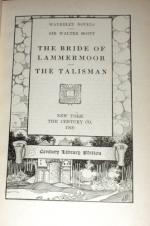While these thoughts were agitating the mind of the wily statesman, and while he was persuading himself that his own interest and safety, as well as those of his friends and party, depended on using the present advantage to the uttermost against young Ravenswood, the Lord Keeper sate down to his desk, and proceeded to draw up, for the information of the privy council, an account of the disorderly proceedings which, in contempt of his warrant, had taken place at the funeral of Lord Ravenswood. The names of most of the parties concerned, as well as the fact itself, would, he was well aware, sound odiously in the ears of his colleagues in administration, and most likely instigate them to make an example of young Ravenswood, at least, in terrorem.
It was a point of delicacy, however, to select such expressions as might infer the young man’s culpability, without seeming directly to urge it, which, on the part of Sir William Ashton, his father’s ancient antagonist, could not but appear odious and invidious. While he was in the act of composition, labouring to find words which might indicate Edgar Ravenswood to be the cause of the uproar, without specifically making such a charge, Sir William, in a pause of his task, chanced, in looking upward, to see the crest of the family for whose heir he was whetting the arrows and disposing the toils of the law carved upon one of the corbeilles from which the vaulted roof of the apartment sprung. It was a black bull’s head, with the legend, “I bide my time”; and the occasion upon which it was adopted mingled itself singularly and impressively with the subject of his present reflections.




